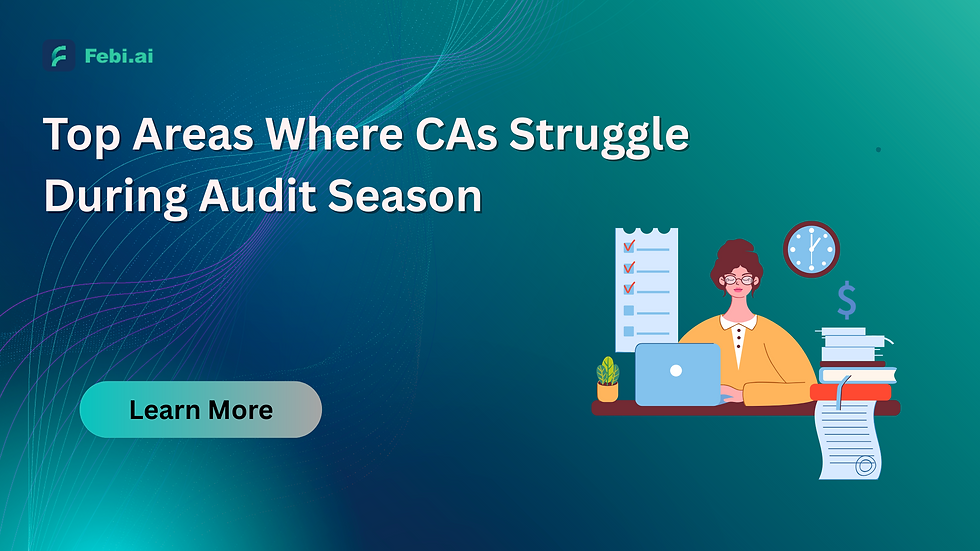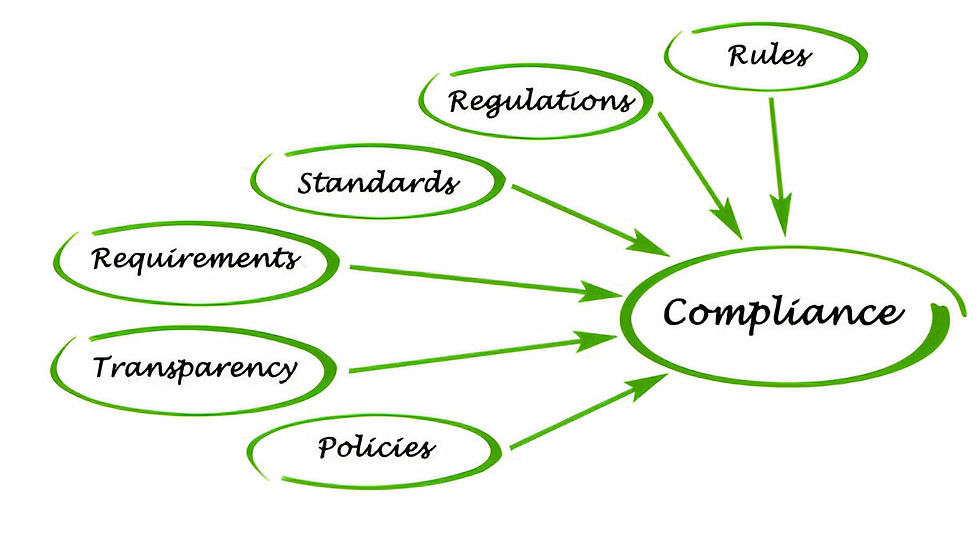Top Areas Where CAs Struggle During Audit Season
- Riya Aggarwal

- Jun 13
- 4 min read

Audit season is one of the busiest and most stressful times of the year for Chartered Accountants (CAs). Whether working independently or as part of a firm, professionals across India and beyond face a wave of challenges that test their efficiency, accuracy, and resilience. From client delays to regulatory complexities, audit season often feels like a race against time.
In this article, we explore the top areas where CAs struggle during audit season, supported by real-world insights and the evolving nature of financial regulations and client expectations.
1. Time Management & Workload Overload
Estimated Impact: 80%+ of CAs
One of the most universal pain points for CAs during audit season is managing time efficiently. With multiple audits to complete within strict deadlines, CAs often end up working extended hours, including weekends and public holidays. The seasonal spike in workload is not just exhausting but also reduces the quality of output due to burnout.
Key contributors:
Tight statutory deadlines (especially March–September in India)
Client delays in data submission
Parallel responsibilities (tax filings, internal audits, financial reviews)
Solution Tip: Use workflow automation tools and resource planning software to allocate tasks effectively. Encourage clients to pre-schedule data handovers to avoid last-minute rush.
2. Delays in Data Collection & Documentation
Estimated Impact: 70–75% of CAs
A recurring frustration for many CAs is the delay in receiving proper documentation from clients. Many businesses are not audit-ready, and their financial records are scattered or incomplete. This creates a domino effect that pushes timelines and increases pressure on the audit team.
Common issues:
Clients using outdated or manual record-keeping methods
Incomplete invoices, bank statements, or ledger entries
Missing or unsigned compliance documents
Solution Tip: Set clear documentation checklists and conduct pre-audit reviews to flag missing records. Offer clients a simple shared drive or portal for streamlined submissions.
3. Regulatory Complexity & Changing Standards

Estimated Impact: 65–70% of CAs
Keeping up with frequent updates in tax laws, accounting standards (such as Ind AS), and audit guidelines (such as SA standards) is a growing challenge. What complicates matters further is the variation across sectors and sizes of enterprises. The burden of compliance, especially in industries like banking, manufacturing, and exports, is much higher.
Major stress points:
Ever-evolving GST norms and reconciliations
Application of CARO, ICDS, and Companies Act provisions
SEBI and RBI reporting for regulated entities
Solution Tip: Maintain an internal compliance tracker and subscribe to reliable regulatory update platforms. Regular training sessions for audit teams can help minimize compliance-related errors.
4. Manual Processes & Lack of Automation
Estimated Impact: 60% of CAs
Despite the rise of digital tools, many audit procedures still rely on Excel sheets, manual vouching, and physical documentation. Manual methods increase the risk of oversight and inefficiency. In large audits, reconciliation and testing without automation can consume days of effort.
Examples:
Manual bank reconciliation statements
Sample testing without audit analytics tools
Use of traditional methods for GST or TDS checks
Solution Tip: Invest in cloud accounting software, audit tools (like CCH, IDEA), and reconciliation platforms. Automating even a portion of the audit workflow can reduce turnaround time significantly.
5. Poor Client Coordination & Communication Gaps
Estimated Impact: 55–60% of CAs
CAs often face poor coordination between the audit team and client-side finance teams. Many clients are not aware of audit procedures or timelines, which causes friction. In some cases, client teams are too lean or inexperienced to provide meaningful assistance during the audit.
Challenges include:
No single point of contact at the client’s end
Repeated follow-ups for the same documents
Misunderstandings on reporting requirements
Solution Tip: Hold a kickoff meeting with the client to set expectations and define responsibilities. Use project management tools like Trello or Asana to track deliverables collaboratively.
6. Cybersecurity & Data Privacy Concerns

Estimated Impact: 50–55% of CAs
With audits increasingly relying on digital data, cybersecurity is now a legitimate concern. Client information such as financials, employee records, and contracts must be stored and shared securely. Any lapse in data privacy can lead to serious reputational and legal consequences.
Key risks:
Sharing sensitive files over unencrypted emails
Use of insecure third-party storage apps
No internal data protection policies
Solution Tip: Use secure file-sharing systems, enable two-factor authentication, and educate both staff and clients on cyber hygiene. Tools like Google Workspace, Dropbox Business, or dedicated DMS platforms can help secure file access.
7. Pressure to Deliver Quick Reports
Estimated Impact: 50% of CAs
Clients often push for quick turnaround on audit reports for reasons such as bank loans, funding, or board meetings. However, hurried audits increase the risk of material misstatements or overlooking internal control deficiencies.
Concerns include:
Cutting down audit sample sizes
Rushing review processes
Overlooking fraud indicators or control gaps
Solution Tip: Set realistic delivery dates at the start and explain the consequences of rushed audits. Have internal quality control checklists to ensure that key areas are not compromised under pressure.
8. Inadequate Staff Training & Skill Gaps
Estimated Impact: 45–50% of CAs
Junior staff often lack exposure to current audit methodologies or sector-specific requirements. In the peak of audit season, this leads to errors, rework, and slower audits. Audit firms relying on articles and freshers feel this pinch the most.
Typical issues:
Poor understanding of sample testing
Incorrect vouching or audit trail creation
Inability to use audit software
Solution Tip: Train staff before audit season with mock audits, sector briefs, and updates on auditing standards. Encourage knowledge sharing within the team to bridge experience gaps.
Final Thoughts
Audit season doesn’t have to be a period of chaos. By understanding and preparing for these common struggles, CAs can not only survive but thrive during this demanding time of the year. Leveraging technology, improving client communication, and continuously training audit teams are key enablers of a smoother audit process.
In a profession where accuracy and timeliness are paramount, strategic planning and proactive problem-solving make all the difference. The CAs who adapt best to these recurring challenges are the ones who deliver not just audit reports, but real value to their clients.



Comments